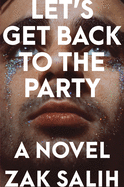
| Publisher: | Algonquin | |
| Genre: | Friendship, Coming of Age, Fiction, Gay, LGBTQ+ | |
| ISBN: | 9781616209575 | |
| Pub Date: | February 2021 | |
| Price: | $25.95 |
| Starred | Fiction |
by Zak Salih
Zak Salih's searching, incisive debut novel finds two gay millennial men making sense of their place in the culture, the struggle and each other's lives circa 2015, not long after the legalization of same-sex marriage in the United States--and not long before the shooting at Orlando's Pulse nightclub. Sebastian, a high-school art history teacher, quails at hookup culture and mentors LGBTQ students whose freedoms he wishes he had enjoyed growing up.
Meanwhile, Oscar, a friend of Sebastian from childhood, cruises Washington, D.C., with his hookup app, outraged at what he sees as the mainstreaming of gay life, a phenomenon exemplified by conventional weddings and the omnipresence of straight women at gay bars. Estranged for decades, Salih's dual protagonists spend the novel circling and avoiding each other, a dance of love, friendship and self-definition: each represents, in many ways, what the other believes gay men should not be.
Each becomes movingly entwined with a representative of another generation of gay life. A teen student, so out and open, fascinates Sebastian, while Oscar becomes a sort of muse to a towering figure of late 20th-century gay literature, a defiant Greenwich Village hedonist who chronicled his prodigious sexual feats in books until his subject shifted, in the 1980s, to the memorialization of a dying generation. A contemporary American meditation on gay life, Salih's novel thrums with details and moments that keep the material from ever edging toward the schematic. Instead, Let's Get Back to the Party is as rich in feeling and compelling in its storytelling as it is acute in its analysis. --Alan Scherstuhl, freelance writer and editor

| Publisher: | Two Lines Press | |
| Genre: | Psychological, Hispanic & Latino, Short Stories (single author), Magical Realism, Literary, Fiction | |
| ISBN: | 9781949641097 | |
| Pub Date: | February 2021 | |
| Price: | $19.95 |
| Starred | Fiction |
by Elvira Navarro, trans. by Christina MacSweeney
Elvira Navarro was listed as one of Granta's "Best of Young Spanish-Language Novelists" in 2010. The 10 surreal, occasionally humorous and tender stories in Rabbit Island are sublime walks through a melancholic blood-flecked dreamscape.
An author seeks an "aura of serene iciness" for her writing, while a paw slowly grows from her earlobe, in "Strychnine"--an autobiographical warning to Navarro's audience. In the titular "Rabbit Island," a man alters an uninhabited island, with gruesome consequences. The result is a compelling take on cycles of colonialism and environmental degradation. Meanwhile, "Regression" comments on marginalization by marrying near-fugue states with the nature of cities and the often-ahistorical memories and vagaries of youth. A man in the sinister "Notes on the Architecture of Hell" questions reality while secretly following his brother, whose mind is like a "tangle of overlapping strata," around the haunted streets of Madrid.
In "Paris Périphérie," a woman with a muddled sense of direction declares loss of memory "frightening" as well as "liberating." Navarro both indicts and reveres the function of memory. And in "The Top Floor Room," another woman is transforming, finding comfort in being a "nocturnal animal" in the streets as a "cierzo [blows]." Place is again invoked as characters break free, for better or worse, from accepted realities and constraints.
Navarro's characters seek larger meaning, often flirting with or downright plunging into cruelty to produce connections, seize control or merely be anywhere other than where they are. Unsettling and full of ghosts, Rabbit Island lays bare the remarkable heart of a hungry and somewhat terrifying philosopher. --Shannon Hanks-Mackey, writer and editor

| Publisher: | Little, Brown | |
| Genre: | Women, Short Stories (single author), Literary, Fiction | |
| ISBN: | 9780316450812 | |
| Pub Date: | February 2021 | |
| Price: | $26 |
| Fiction |
by Maria Adelmann
Teens and young adult women populate the majority of stories in Girls of a Certain Age, an intriguing first collection by Maria Adelmann. "Pets Are for Rich Kids" features two girls, one whose constant needing and wanting makes her "callous," the other whose taken-for-granted easy comfort allows her to believe she's generous. Inequitable friendship reappears again with an older cast in "Middlemen," about a young woman whose wealthier roommate takes advantage of her emotionally and sexually.
In "Only the Good," meaningless hook-ups leave a young woman pregnant, with only her brother for comfort. But Adelmann saves the best for last with "The Wayside." Here, a 17-year-old spends her summer before college working at the titular, historical Concord, Mass., home where Nathanial Hawthorne wrote some of his most famous works. Relationships with her divorced parents, a beloved but missing sibling, impatient friends, her first (manipulative) lover, older colleagues will all define her journey toward maturity.
Throughout Adelmann's observant stories, what proves most affecting is her ability to create recognizable women and girls leading convincing, albeit challenging, daily lives. Adelmann writes with a sharp, detailed precision that can immediately reveal complex situations: for a young deaf girl, deciphering her mother's words is to watch "her lips like two pieces of ribbon"; the distinctive smell of pickle juice at lunch becomes the leitmotif for a young woman's desperation to conform to the beauty standards that might get her seen on screen. With eyes wide open, Adelmann carefully observes and meticulously records what happens to these girls of a certain age, paying special attention to those too easily ignored, overlooked and dismissed. --Terry Hong, Smithsonian BookDragon
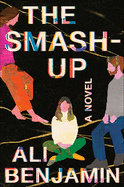
| Publisher: | Random House | |
| Genre: | Women, Family Life, General, Literary, Fiction | |
| ISBN: | 9780593229651 | |
| Pub Date: | February 2021 | |
| Price: | $27 |
| Fiction |
by Ali Benjamin
The Smash-Up, Ali Benjamin's first novel for adults, is an eviscerating and hilarious look at the destabilizing effect of 2018's confirmation hearings of Supreme Court Justice Brett Kavanaugh on a marriage--not one of political opposites, but of ostensibly like-minded liberals.
Ethan and Zenobia Frome live in small-town Starkfield, Mass. (Benjamin will gesture several times toward Edith Wharton's novel.) Fifteen years earlier, they left Brooklyn so that "Zo could make her films in peace" and "Ethan could write novels, maybe a screenplay or two." It hasn't worked out that way.
After Zo attended the Women's March with some local women, they formed All Them Witches, which meets regularly at the Frome house. Ethan understands their outrage, but he's noticed that Zo's anger seems to be keeping her from her work.
Ethan has been awaiting the money owed to him by Bränd, the marketing firm that he and his college buddy Randy started two decades earlier, but there's a clog in the cash pipeline: as the novel opens, Ethan learns that Randy has been publicly called out for the sort of behavior that would make All Them Witches want to see the man's head on a pike. Worse, Randy is appealing to Ethan to fix the problem.
Perhaps a novel fueled by 2018's emotions-churning confirmation hearings was inevitable; what wasn't inevitable was that the book would be this good. Punching neither up nor down but to the side, Benjamin (The Thing About Jellyfish) takes aim at a contemporary attitude that would have flummoxed Edith Wharton. As one of Benjamin's characters puts it, "When did we all fall so in love with our own opinions?" --Nell Beram, author and freelance writer

| Publisher: | Del Rey | |
| Genre: | Suspense, Thrillers, Fiction, Action & Adventure, Technological, Science Fiction | |
| ISBN: | 9780593158210 | |
| Pub Date: | February 2021 | |
| Price: | $27 |
| Mystery & Thriller |
by Dan Frey
Dan Frey (The Retreat) does a bang-up job imagining a scenario in which computers can communicate with their future selves and the impact that could have on society on a variety of levels. Cleverly told entirely via documentation (e-mails, blog posts, texts, reports, etc.) to avoid spoilers, The Future Is Yours is an "opposites attract" tale of friendship set in the thought-provoking and cutthroat world of technology.
Ben Boyce, a confident connection-maker with a gift for wooing venture capitalists, and Adhvan "Adhi" Chaudry, an intellectual genius with woeful people skills, become best friends while rooming together at Stanford University. The story begins with an e-mail sent by Ben to Adhi from a year in the future--immediately proving Stanford whiffed by not backing Adhi's Ph.D. thesis proposing communication with the future using quantum computing.
The engrossing road from college to rolling out their product, a computer-type unit called The Future, is centered around the transcript of a 2021 congressional hearing where the legality of The Future is to be decided. Despite a subpoena, Adhi is mysteriously absent from the hearing. Frey ups the suspense by putting limitations on The Future: it can see only into a one-year future window, to a reality that cannot be altered.
Unsurprisingly, data from The Future becomes problematic. As Adhi struggles with morality issues, Ben drives passionately ahead, their friendship, relationships and the future of the world at risk. Frey's work as a screenwriter shines through in form and substance in this gripping work of science fiction. --Lauren O'Brien of Malcolm Avenue Review

| Publisher: | Tor | |
| Genre: | Fantasy, Fiction, Action & Adventure, Science Fiction | |
| ISBN: | 9781250782120 | |
| Pub Date: | February 2021 | |
| Price: | $13.99 |
| Science Fiction & Fantasy |
by Aimee Ogden
The Little Mermaid acts as a launching point for something beautiful and strange in Sun-Daughters, Sea-Daughters, the debut novella from prolific short story author Aimee Ogden.
Years ago, Atuale, the daughter of a Sea-Clan lord, turned her back on her people to take a husband on land with the help of technology from Yanja, her former lover, also known as the World-Witch. Now a plague has struck the land-dwellers, and the only way to save her husband is for Atuale to turn again to the World-Witch, whose black-market connections may help to find a cure off-world.
Slim but rich, this novella has its heart in the relationship between Atuale and Yanja. Atuale is a refreshingly uncynical depiction of the fairy tale princess grown up: still brave and longing for adventure, still in love with her husband, disappointed only that they have had no children together. Yet Yanja was the lover of her youth, and those ties remain strong even if they parted when Yanja's assistance in adapting Atuale for life on land led to a war among the sea lords. Yanja makes for a pleasing counterweight: mercenary, acerbic, but perhaps with more loyalty than one might think at first glance. As the two fight against time and bureaucracy, Atuale also examines the decisions she made in the past and what she wants for her future. This novella will leave readers eager for more from Ogden. --Kristen Allen-Vogel, information services librarian at Dayton Metro Library

| Publisher: | Scribner | |
| Genre: | Biography & Autobiography, Middle East, Terrorism, Personal Memoirs, General, History, Political Science | |
| ISBN: | 9781982120825 | |
| Pub Date: | February 2021 | |
| Price: | $27 |
| Biography & Memoir |
by Theo Padnos
In 2012, American freelance journalist Theo Padnos crossed the Turkish border into Syria with the help of the men who became his kidnappers. Blindfold: A Memoir of Capture, Torture, and Enlightenment recounts his subsequent terrifying ordeal, providing insight into war-torn Syria and his jailers, who belonged to the al Qaeda affiliate Jebhat al-Nusra. Padnos is unsparing in describing the combination of naiveté, idealism and recklessness that helped lead him into the arms of his kidnappers; over the course of nearly two years in captivity, he was abused, tortured and starved. Padnos describes the remarkable mental adaptations that helped him survive against all odds.
The titular blindfold refers to a scrap of fabric given to Padnos near the beginning of his captivity. It became a source of comfort for him, in part because its flimsiness sometimes allowed him to see what he was not meant to see. Thus, even as a captive kept in a series of cramped prisons, Padnos was able to witness terrible and remarkable things, from executions and indoctrination to the ordinary hopes and dreams of his captors and fellow prisoners. Blindfold is therefore not only an incredible survival story, but also a record of what Padnos considers a psychic transformation taking place around him that allows his captors to believe that "one's handgun is an instrument of God, and that in murdering a helpless woman in the street, one is bringing justice to Syria." Blindfold is invaluable as a record of these invisible changes rippling through Syria. --Hank Stephenson, the Sun magazine, manuscript reader
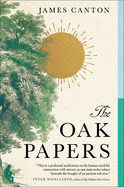
| Publisher: | HarperOne | |
| Genre: | Nature, Trees, Biography & Autobiography, Technology & Engineering, Physical, Personal Memoirs, Forestry, Anthropology, Agriculture, Plants, Social Science | |
| ISBN: | 9780063037946 | |
| Pub Date: | February 2021 | |
| Price: | $27.99 |
| Social Science |
by James Canton
James Canton (Ancient Wonderings; Out of Essex) spends hours, days, months and years with one particular oak tree. Moved by its power and continually fascinated by its individuality, Canton undertook a study of the connection between oaks and people. After consulting history, mythology, spirituality, science, a number of individual woodmen and -women, and more time spent in the company of oaks, he offers The Oak Papers, part personal reflection and part research project.
The Honywood Oak, at the Marks Hall Estate near London, draws Canton in. During a period of personal turmoil, he finds himself sitting under this massive 800-year-old tree, "a mere sapling when the Magna Carta was signed." He watches birds and insects and hares, and the changing seasons; he finds himself returning just to spend time with the Honywood Oak and feels a healing effect. Canton's more purposeful studies begin in the company of the estate's "curator of trees," and in his readings: Dante, T.S. Eliot, Pliny, Woolf and many others.
The Oak Papers is meticulous and dense with detailed observations not only of oaks--the seasonal variations in their leaves, buds and acorns--but of the lives they support: heron, wood butterfly, mosses, lichen, hare, gall wasp. The bulk of these papers sees Canton sitting and watching, although he also recounts visits with people who know oaks well: artists and craftspeople who work with wood, spiritual thinkers, a psychologist who specializes in nature therapies. He lovingly concludes that "there are many paths to seeking the truths about oaks" and that "we all become better beings when we step back into the woods." --Julia Kastner, librarian and blogger at pagesofjulia
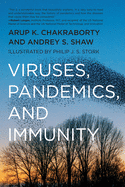
| Publisher: | The MIT Press | |
| Genre: | Life Sciences, Forensic Medicine, Public Health, Science, Medical, Health Policy, Virology | |
| ISBN: | 9780262542388 | |
| Pub Date: | February 2021 | |
| Price: | $19.95 |
| Science |
by Arup K. Chakraborty, Andrey S. Shaw, illust. by Philip J.S. Stork
Never in recent times has the study of plagues and contagions--their presence and power--been more relevant than during the global Covid-19 crisis. Three renowned scientists--one of whom serves as illustrator--present an accessible, highly informative analysis of viruses and pandemics and their existential threat.
They offers a concise history of viruses. The Constantinople pandemic in 500 AD wiped out half of the European population. The great bubonic plague of the 14th century spread through China, the Middle East and Europe, killing roughly 100 million people. The 1918 influenza pandemic originally emerged as a seasonal flu that escalated to claim countless lives--similar flu-like occurrences also snowballed in 1957, 1968 and 2009. Outbreaks of cholera, smallpox, tuberculosis, measles, leprosy, malaria, HIV and Ebola have also contributed to widespread global death.
Through fascinating examples of scientists working behind the scenes, Chakraborty, Shaw and Stork explain--through an easy-to-follow narrative and well-rendered visuals--how viruses function and emerge to create epidemics. They examine how the human immune system responds and tries to combat viral invasions, and they offer further insights into the role of diagnostic tests, antiviral medications and vaccines.
The war against infectious disease and pandemics will continue. However, this fascinating, thoroughly researched book offers much hope. The authors stress how knowledge gained from pandemics--mapping the mutation of viruses and the determined, ongoing quest toward mitigation and eradication--will serve to make the world more "pandemic resistant" in the future. --Kathleen Gerard, blogger at Reading Between the Lines
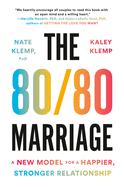
| Publisher: | Penguin Life | |
| Genre: | Family & Relationships, Self-Help, Communication & Social Skills, Conflict Resolution, Marriage & Long Term Relationships | |
| ISBN: | 9781984880772 | |
| Pub Date: | February 2021 | |
| Price: | $26 |
| Parenting & Family |
by Nate Klemp, Kaley Klemp
If anyone can help couples handle marriage in the modern age, it is professor of philosophy and mindfulness expert Nate Klemp and corporate leadership expert Kaley Klemp. The husband-and-wife experts team up in their helpful book 80/80 Marriage: A New Model for a Happier, Stronger Relationship to aid couples in finding "a new model of marriage, a way of being together that offers a safe haven from the stress of modern life and access to the experiences that make marriage worth fighting for."
Klemp and Klemp propose that there have been, broadly speaking, several power dynamics in marriages. The 80/20 is a model of asymmetrical power and inequality defined by a mindset of deference and control, they say, as well as a structure of rigid gender roles, that contributes to an underlying belief system of "not my job." The 50/50 model moves toward a mindset of fairness, but results in an underlying belief system of "when you win, I lose" and role confusion within the relationship. Instead, they propose a new system, the 80/80 model, where partners have a mindset of radical generosity and thus structure their relationship around shared successes to help everyone win.
With exercises in each chapter, anecdotes and plenty of their own life experience, the Klemps thoughtfully and thoroughly highlight how couples can move from patterns of conflict to creative methods of resolution; cope with myriad challenges, from shared responsibilities to setting boundaries; and unlock more spaces for intimacy in a world that intrudes more intensely and more frequently into family lives. --Michelle Anya Anjirbag, freelance reviewer
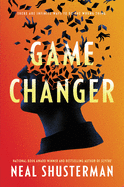
| Publisher: | Quill Tree/HarperCollins | |
| Genre: | Fantasy, Contemporary, Sports & Recreation, Coming of Age, Young Adult Fiction, Football | |
| ISBN: | 9780061998676 | |
| Pub Date: | February 2021 | |
| Price: | $17.99 |
| Starred | Children's & Young Adult |
by Neal Shusterman
National Book Award winner Neil Shusterman's Game Changer is a brilliantly mind-bending YA work of speculative fiction that tells the story of Ash Bowman, high school football player and "subjective locus" of the entire universe.
Prior to his paradigm shift, Ash's life is nothing out of the ordinary--a "sturdy," white defensive lineman with a passion for football, he's good but not quite as good as his Black best friend Leo, the team's star wide receiver. Then Ash delivers a heavy blow to an opposing team's quarterback. Ash's concussed brain "misfires" and he begins to notice that things are not quite right: stop signs are blue, "separate but equal" is the law of the land, and a boy Ash doesn't know is now his team's wide receiver. Ash has become the literal center of the universe, and every time he gives a huge hit, he bounces "what is into a variation of what isn't." With the help of his friends, his brother and a squad of snarky multidimensional beings, Ash hopes to find a way to reset his life. Turns out, being the center of the universe isn't nearly as fun as it sounds.
Game Changer explores some of the problems facing the United States and the world today: systemic racism, homophobia, sexism. Shusterman (Challenger Deep; Scythe; Dry) fictionalizes these big issues while simultaneously making connections to our own reality, prompting readers to question how their own biases and privilege might distort their perception of the world. Game Changer is a book with a sense of humor and an existential bent that is overflowing with biting social commentary and aphoristic wisdom. Easy to read, with perspective-altering drama, this novel is on track to become the go-to contemporary fable for this generation of readers. --Cade Williams, freelance reviewer
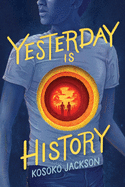
| Publisher: | Sourcebooks Fire | |
| Genre: | Romance, Social Themes, Young Adult Fiction, Prejudice & Racism, LGBTQ+ | |
| ISBN: | 9781492694342 | |
| Pub Date: | February 2021 | |
| Price: | $17.99 |
| Children's & Young Adult |
by Kosoko Jackson
Queer romance with a time traveling twist builds to an affecting climax in Kosoko Jackson's YA debut, Yesterday Is History.
Seventeen-year-old Andre Cobb is a recent cancer survivor and organ transplant recipient. His new liver saved his life--and gave him the ability to travel in time. His life is thrown into a romantic tailspin when he falls for Michael, a gorgeous musician back in 1969, as well as Blake, the headstrong athlete (from a family of time-travelers) who is trying to teach Andre how to master his powers in 2021. Rapid pacing jolts readers between the past and present, giving readers the kind of temporal whiplash Andre himself experiences.
Jackson includes a fascinating descriptive aspect that grounds both Andre and readers while also adding a level of realism to the narrative's sci-fi premise: Andre makes regular note of the altered landmarks around Boston, such as Faneuil Hall. He also uses Andre's understanding of himself as a contemporary Black gay teen to interject social commentary about the evolution of the gay rights movement. As Andre moves between decades, he becomes more aware of his own connections in marginalized communities and the struggles each presents. As Michael boldly states during one of Andre's "jumps" to visit him in the past, "Being out and being proud? Being Black and gay? None of that must be easy, no matter what time it is."
At its core, Jackson's novel is a love story about discovering romantic intimacy and learning how letting love go may allow more love to blossom in the future. --Rachel Werner, Hugo House and The Loft Literary Center faculty
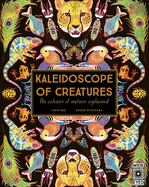
| Publisher: | Wide Eyed Editions | |
| Genre: | Animals, Zoology, General, Science & Nature, Biology, General (See Also Headings Under Animals or Technology), Juvenile Nonfiction | |
| ISBN: | 9780711258754 | |
| Pub Date: | February 2021 | |
| Price: | $24.99 |
| Children's & Young Adult |
by Cath Ard, illust. by Greer Stothers
Critters across the animal kingdom gather by hue and pattern in Cath Ard and Greer Stothers's vibrant and evocative Kaleidoscope of Creatures: The Colors of Nature Explained.
Ard (the In Training series) dedicates every double-page spread to a range of animal colors and markings that are all connected by hue. On each page, there is an overview of the animal coverings' purpose in nature, which, along with the shared color palette, unifies creatures of disparate size, behavior and habitat. Ard highlights several animals per page with highly descriptive language and brief but intriguing facts. A spotted black-and-white inyo toad blends in with "pools of light-dappled water on the forest floor," while a greater blue-eared starling's iridescent feathers "make it gleam like polished metal." Ard notes when creature colors are designed to help animals blend in or stand out, including additional parenthetical descriptors such as "camouflage" or "danger" throughout the book.
Stothers uses risography (a high-speed digital printing method) to great effect, creating brilliant complementary and technicolored backgrounds to emphasize animal arrays. Stothers cleverly uses the book's format, deftly featuring symmetry on several pages and arranging the images so that larger creatures span the gutter. Taking liberties with scale, these page designs fracture the spreads to evoke the kaleidoscope of the book's title.
Eye-catching illustrations should garner immediate interest, while the generous trim size, clean font and sophisticated but digestible text segments suit curious young readers. Supplemental material brackets the book with an animal family tree, glossary, index and environmental call to action. The overall result is both instructive and striking. --Kit Ballenger, youth librarian, Help Your Shelf